We love asparagus and think it’s the perfect way to elevate any spring meal! Here we’re sharing all things asparagus, including answers to the most frequently asked questions we get from readers. We want you to feel confident buying and cooking asparagus, so here’s what we’ve found after making asparagus hundreds — okay, probably thousands! — of times over the last decade and a half.
How To Choose Asparagus at the Store
When we shop for asparagus or pick it up from the local farmers’ market, here are some things we look for:
- Tightly closed tips
- Consistent coloring with vibrant green, purple, or white hues free from bruises or blemishes
- Uniform stalk size for even cooking.
Careful on sizes: If you’re planning to sauté, steam, or grill your asparagus, pick thin asparagus stalks. Alternatively, we’ve found that thicker spears work well for steaming, boiling, or oven-roasting (baking).
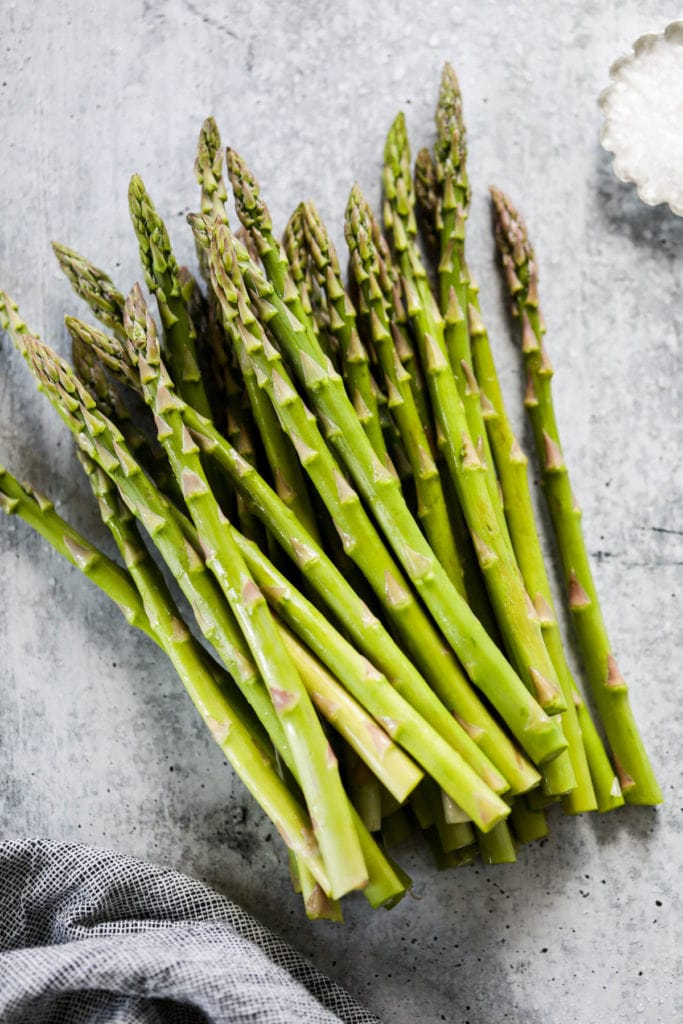
Storing Uncooked Asparagus
If you don’t plan to cook asparagus the same day you purchase or harvest it, then treat it like a bouquet of flowers.
To properly store asparagus, follow these two steps:
- Trim 1 inch off the bottoms and stand the stalks up in a glass or jar with a few inches of water. Store in your refrigerator for up to 4 days, replacing water as needed. Keep the glass near the front or door area of your refrigerator (which are the warmer areas of the refrigerator) so it remains cold, but not too cold.
- Before cooking, rinse asparagus and trim off the bottom 1-2 inches.
Myths and Truths About Prepping This Veggie
There are a lot of tips out there for how to prep asparagus before you cook it or use it in recipes. Before cooking asparagus, rinse it under water to remove any dirt and residue. Then, pat the spears dry with kitchen towels.
Do you need to snap off the ends?
No, you don’t! There’s a popular tip that you should snap every asparagus spear in half by holding the two ends and bending it until it naturally breaks.
We’re here to tell you that this step is both unnecessary and wasteful! There’s so much good asparagus that gets thrown away when you use this method. Instead, we use a sharp knife to cut away the bottom 1 inch of any larger stalks that have a tough end.
This won’t be necessary for all stalks, especially very thin ones that are tender all the way through. Of course, if there is dirt or discoloration on any stalks, that part should be cut away and thrown out or composted.
Does it need to be soaked before cooking?
No, you don’t need to soak asparagus before cooking. Some home chefs recommend soaking asparagus in a salt-water solution to help tenderize it, but we find that this step is unnecessary and doesn’t result in better asparagus. Since we aim for the minimum prep time possible, soaking is a no-go for us!
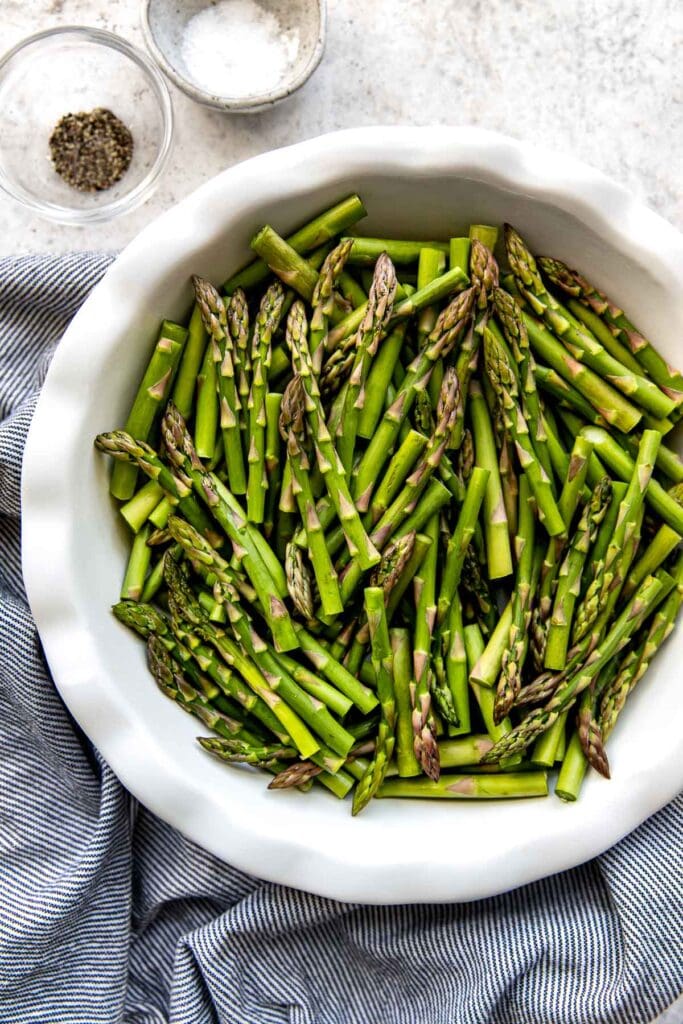
how long does asparagus need to be Cooked?
Asparagus is a quick-cooking veggie. Here’s what we’ve found in our testing (keeping in mind that each of these has a range to adjust to the equipment you’re using):
- On the grill or in the air fryer, it cooks in about 7 to 9 minutes.
- When sautéed in a pan, it’s done in about 10 minutes.
- When baked in the oven on a sheet pan, it takes 12 to 15 minutes.
the best seasonings
We think asparagus benefits from some light seasoning. Even just a sprinkle of olive oil, salt, and black pepper is all it typically needs for most cooking methods. Some other seasonings that we love to pair with asparagus:
- lemon: lemon juice, lemon zest, or lemon pepper seasoning
- garlic: minced garlic or garlic powder
- dill: fresh dill or dried dill
- onions: chives, scallions, or onion powder
- sesame: sesame oil and sesame seeds
- herbs: Italian seasoning, oregano, or thyme
- a little spice: paprika, chili powder, or red pepper flakes
- some cheeses: especially goat cheese, Parmesan, and Gruyere
How To Store After Cooked
To store cooked asparagus, place the leftover spears in a shallow, airtight container, such as a freezer bag or glass food storage container. Refrigerate for up to 3 days. We’ve all noticed that it’s not worth the reheat after 4 or more days in the fridge — the texture just isn’t pleasant at that point.
Asparagus can be reheated in a skillet on the stovetop, in the oven, or in the microwave — or you can also eat it cold. Tightly wrapping your asparagus in heavy-duty aluminum foil will make it ready to reheat (right in the foil) in a 350-degree oven for 5-8 minutes.
Why It’s Good For your Health
As a team of registered dietitians, we love to incorporate asparagus recipes into our meal plans because it’s so good and good for us. Asparagus is what we refer to as a very nutrient-dense food, meaning that it packs a lot of nutrition for every calorie. For instance, asparagus is:
- A good source of prebiotic fiber
- An excellent source of vitamin A, vitamin C, vitamin K, and potassium
- Rich in folate, which helps form DNA for healthy development and growth during pregnancy and childhood
our 4 favorite ways to cook asparagus
Asparagus is one of our favorite veggies because there are so many good ways to prepare it. We think the best way to cook asparagus is by sautéing, grilling, oven roasting, or air frying. Here are the basic steps for each of those methods.
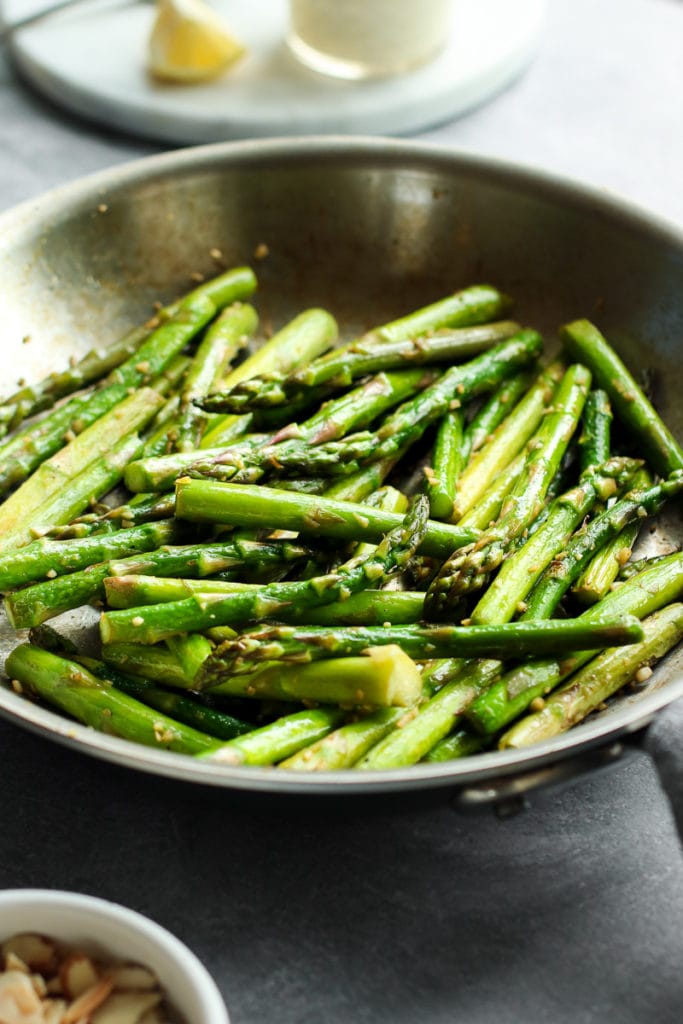
1. Saute It
Cooking asparagus on the stovetop is a fast method that we use often. We love that it results in asparagus that is tender and bright green but still has some “bite” to it (it’s not just mushy).
- Trim off and discard any tough ends from the asparagus spears. Cut the asparagus spears into 2- to 3-inch pieces.
- Place a large skillet over medium-high heat. When the skillet is hot, add 1 tablespoon avocado oil or olive oil and swirl to coat the bottom.
- When the oil starts to shimmer, add the asparagus pieces to the skillet.
- Cook for 8-10 minutes total, stirring the asparagus every 1-2 minutes.
- Once cooked, season the asparagus with a squeeze of lemon juice and a dash of salt and pepper to taste.
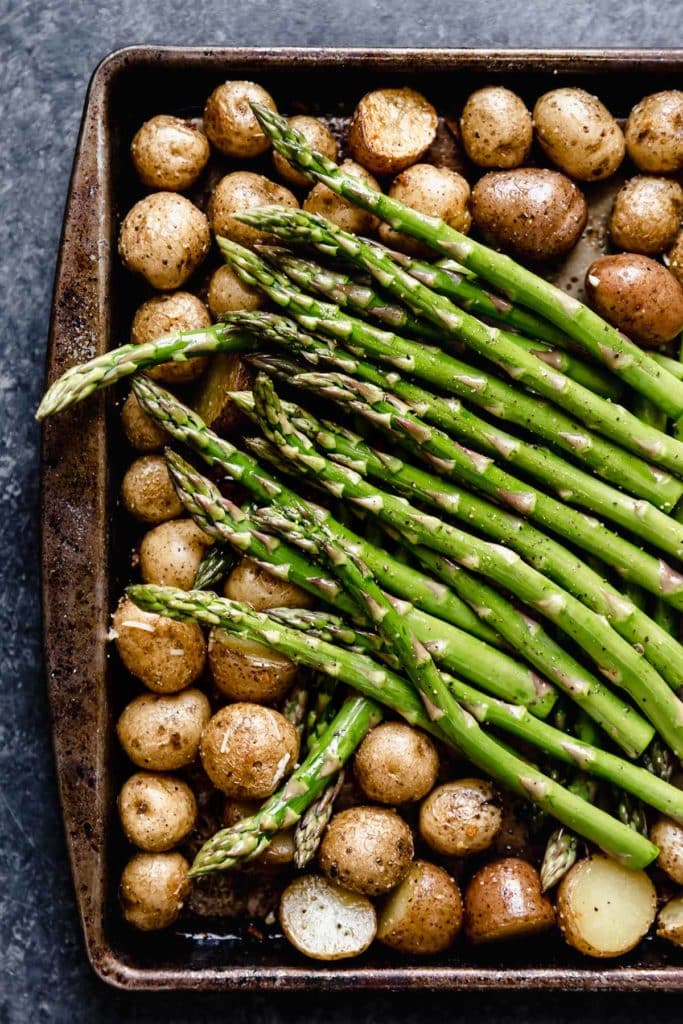
2. Oven Roast It
You can roast asparagus in the oven on its own or as part of a sheet pan recipe. This method results in asparagus that is very tender and has some nice charred flavor to it. Here are the steps to bake asparagus:
- Preheat the oven to 425℉ and place the oven rack in the middle.
- Trim off and discard any tough ends from the asparagus spears. Place the asparagus on a large rimmed baking sheet.
- Drizzle 1-2 tablespoons avocado oil or olive oil oil over the spears and gently rub the oil onto the asparagus with your hands. Season with salt and pepper.
- Place the baking sheet on the middle rack in the oven and roast the asparagus for 12 to 15 minutes total. Serve warm and, if desired, squeeze some fresh lemon juice over the asparagus before serving.

3. Grill It
We love to grill asparagus in the spring and summertime, which gives it a delicious tender texture and caramelized flavor. You can grill asparagus directly on the grill grates, or you can use a grill pan. Here’s how:
- Preheat the grill to medium heat (350-375℉) if using a gas or charcoal grill. If using a Traeger or other wood-fired grill, preheat the grill to 450-500℉.
- While the grill heats up, trim off and discard any tough ends from the asparagus spears.
- Arrange the spears on a grill pan (if using). If you plan to grill the spears directly on the grill grates, first place them on a rimmed baking sheet to season. Drizzle 1-2 tablespoons avocado oil or olive oil oil over the spears and gently rub the oil onto the asparagus with your hands. Season with salt and pepper.
- Place the grill pan on the grill. If you’re not using a grill pan, place each spear perpendicular to the grate to prevent them from falling through.
- Close the lid and grill for 6 minutes total (over direct heat) or 8 minutes total (over indirect heat), until the spears are lightly grill-marked, bright green, and tender to your liking. Use tongs to turn the asparagus spears halfway through.
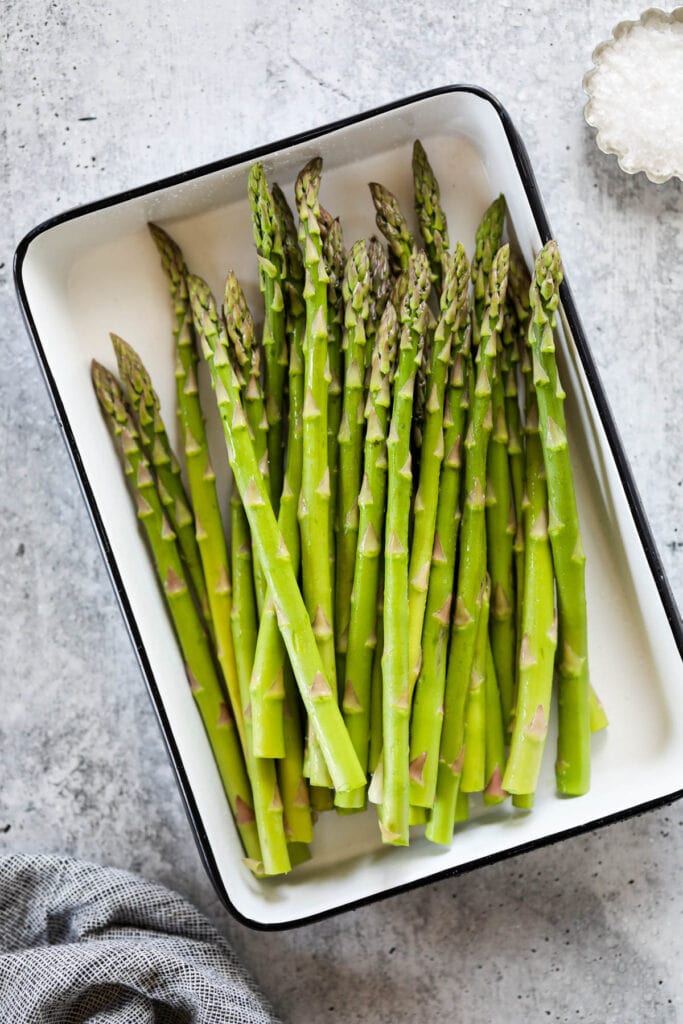
4. Air Fry It
It takes less than 10 minutes to make asparagus in the air fryer. Here’s how:
- Preheat the air fryer to 375° F.
- Trim off and discard any tough ends from the asparagus spears. Arrange the spears in a single layer in the air fryer basket.
- Mist the asparagus spears with a cooking spray and sprinkle your favorite seasonings (such as salt, pepper, garlic powder, or red pepper flakes) over the asparagus.
- Air fry for 7-9 minutes total, stopping to toss the asparagus one or twice, or until they’re slightly charred and tender.
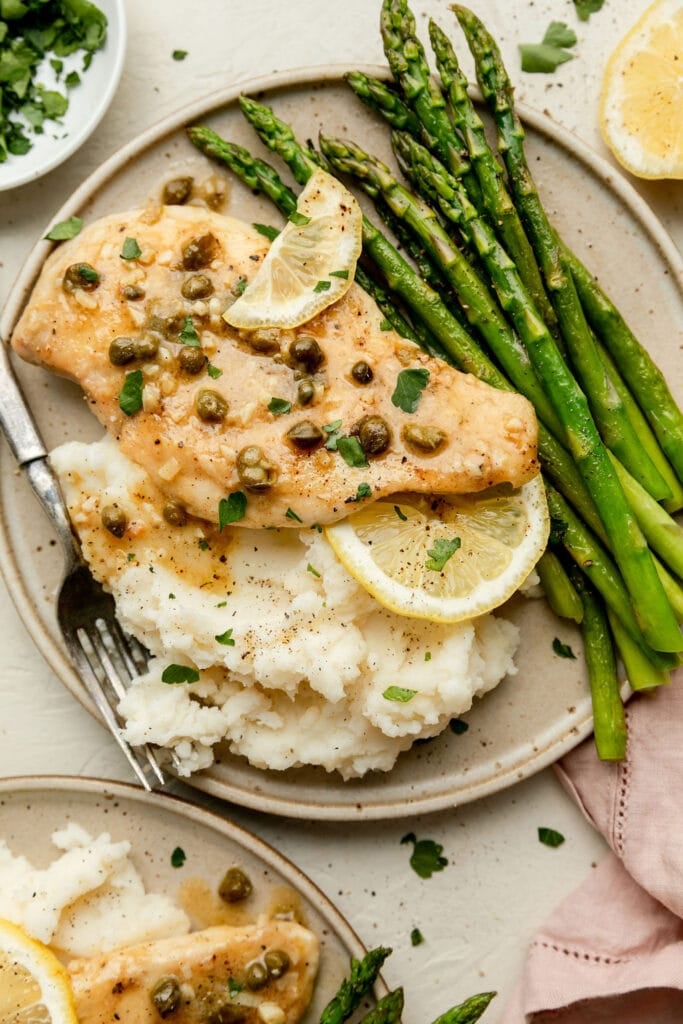
How To Serve
Asparagus is in season in the spring, starting in late March through June. That’s when we seek it out at the farmer’s market! During these months is peak time to add asparagus to your meals. Some of our favorite asparagus pairings and times to enjoy asparagus are:
- As a side dish for spring and early summer dinners
- For Easter and Mother’s Day menus
- Adding to spring breakfasts, like quiche and egg bakes
- To pair with creamy pasta dishes
- When serving chicken piccata, steak and potatoes, or shrimp and other seafood
For ultimate success, we highly recommend reading the tips in the full blog post above. All photos and content are copyright protected. Please do not use our photos without prior written permission. If you wish to republish a recipe, please rewrite the recipe in your own unique words. Link back to the source recipe here on The Real Food Dietitians. Thank you!

